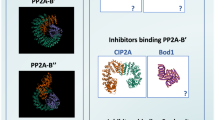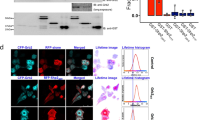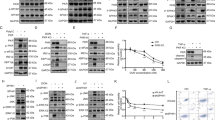Abstract
Stress signals elicit a wide variety of cellular responses, many of which converge on the phosphorylation of JNK and p38 kinases, the activation of which has been well-characterized. How these kinases are switched off by dephosphorylation is not well understood. Here we describe how diverse cellular stresses affect differently the stability and activity of a JNK-inactivating dual-specificity threonine-tyrosine phosphatase M3/6. Both anisomycin and arsenite activate the JNK pathway and, in addition, inactivate the M3/6 phosphatase. However, while anisomycin treatment of cells leads to M3/6 protein degradation, arsenite appears to inactivate M3/6 directly. These results might have implications for the mechanism of tumour promotion by arsenic.
This is a preview of subscription content, access via your institution
Access options
Subscribe to this journal
Receive 50 print issues and online access
$259.00 per year
only $5.18 per issue
Buy this article
- Purchase on Springer Link
- Instant access to full article PDF
Prices may be subject to local taxes which are calculated during checkout







Similar content being viewed by others
Abbreviations
- HEK293 cells:
-
human embryonic kidney 293 cells
- JNK:
-
c-Jun N-terminal kinase
- SAPK:
-
stress-activated protein kinase
- ERK:
-
extracellular signal-regulated kinase
- SEK1:
-
SAPK/ERK kinase 1
- DMSO:
-
dimethyl sulphoxide
- FCS:
-
foetal calf serum
- GST:
-
glutathione S-transferase
References
Adler V, Unlap T, Kraft AS . 1994 J. Biol. Chem. 269: 11186–11191
Baichwal VR, Tjian R . 1990 Cell 63: 815–825
Bernstam L, Nriagu J . 2000 J. Toxicol. Environ. Health B. Crit. Rev. 3: 293–322
Brondello JM, Pouyssegur J, McKenzie FR . 1999 Science 286: 2514–2517
Camps M, Nichols A, Gillieron C, Antonsson B, Muda M, Chabert C, Boschert U, Arkinstall S . 1998 Science 280: 1262–1265
Camps M, Nichols A, Arkinstall S . 2000 FASEB J. 14: 6–16
Cavigelli M, Li WW, Lin A, Su B, Yoshioka K, Karin M . 1996 EMBO J. 15: 6269–6279
Chen Y-R, Tan T-H . 2000 Int. J. Oncol. 16: 651–662
Cuenda A, Rouse J, Doza YN, Meier R, Cohen P, Gallagher TF, Young PR, Lee JC . 1995 FEBS Lett. 364: 229–233
Davis RJ . 1999 Biochem. Soc. Symp. 64: 1–12
Davis RJ . 2000 Cell 103: 239–252
Favata MF, Horiuchi KY, Manos EJ, Daulerio AJ, Stradley DA, Feeser WS, Van Dyk DE, Pitts WJ, Earl RA, Hobbs F, Copeland RA, Magolda RL, Scherle PA, Trzaskos JM . 1998 J. Biol. Chem. 273: 18623–18632
Fenteany G, Standaert RF, Lane WS, Choi S, Corey EJ, Schreiber SL . 1995 Science 268: 726–731
Fuchs SY, Dolan L, Davis RJ, Ronai Z . 1996 Oncogene 13: 1531–1535
Fuchs SY, Xie B, Adler V, Fried VA, Davis RJ, Ronai Z . 1997 J. Biol. Chem. 272: 32163–32168
Fuchs SY, Fried VA, Ronai Z . 1998 Oncogene 17: 1483–1490
Garcia-Guzman M, Dolfi F, Zeh K, Vuori K . 1999 Oncogene 18: 7775–7786
Gupta S, Campbell D, Derijard B, Davis RJ . 1995 Science 267: 389–393
Ip YT, Davis RJ . 1998 Curr. Opin. Cell Biol. 10: 205–219
Hazzalin CA, Le Panse R, Cano E, Mahadevan LC . 1998 Mol. Cell. Biol. 18: 1844–1854
Jacobs D, Glossip D, Xing H, Muslin AJ, Kornfeld K . 1999 Genes Dev. 13: 163–175
Johnson TR, Biggs JR, Winbourn SE, Kraft AS . 2000 J. Biol. Chem. 275: 31755–31762
Keyse SM . 2000 Curr. Opin. Cell Biol. 12: 186–192
Keyse SM, Ginsburg M . 1993 Trends Biochem. Sci. 18: 377–378
King RW, Deshaies RJ, Peters JM, Kirschner MW . 1996 Science 274: 1652–1659
Kyriakis JM, Avruch J . 1996 Bioessays 18: 567–577
Kyriakis JM, Banerjee P, Nikolakaki E, Dai T, Rubie EA, Ahmad MF, Avruch J, Woodgett JR . 1994 Nature 369: 156–160
Ludwig S, Hoffmeyer A, Goebeler M, Kilian K, Hafner H, Neufeld B, Han J, Rapp UR . 1998 J. Biol. Chem. 273: 1917–1922
Meriin AB, Yaglom JA, Gabai VL, Zon L, Ganiatsas S, Mosser DD, Sherman MY . 1999 Mol. Cell. Biol. 19: 2547–2555
Muda M, Theodosiou A, Rodrigues N, Boschert U, Camps M, Gillieron C, Davies K, Ashworth A, Arkinstall S . 1996 J. Biol. Chem. 271: 27205–27208
Muda M, Theodosiou A, Gillieron C, Smith A, Chabert C, Camps M, Boschert U, Rodrigues N, Davies K, Ashworth A, Arkinstall S . 1998 J. Biol. Chem. 273: 9323–9329
No D, Yao TP, Evans RM . 1996 Proc. Natl. Acad. Sci. USA 93: 3346–3351
Raitano AB, Halpern JR, Hambuch TM, Sawyers CL . 1995 Proc. Natl. Acad. Sci. USA 92: 11746–11750
Rechsteiner M, Rogers SW . 1996 Trends Biochem. Sci. 21: 267–271
Rodrigues GA, Park M, Schlessinger J . 1997 EMBO J. 16: 2634–2645
Slack DN, Seterns O-M, Gabrielsen M, Keyse SM . 2001 J. Biol. Chem. 276: 16491–16500
Smith A, Ramos-Morales F, Ashworth A, Collins M . 1997 Curr. Biol. 7: 893–896
Snow ET . 1992 Pharmacol. Ther. 53: 31–65
Sun H, Charles CH, Lau LF, Tonks NK . 1993 Cell 75: 487–493
Tanoue T, Moriguchi T, Nishida E . 1999 J. Biol. Chem. 274: 19949–19956
Tanoue T, Adachi M, Moriguchi T, Nishida E . 2000 Nat. Cell Biol. 2: 110–116
Tanoue T, Yamamoto T, Maeda R, Nishida E . 2001 J. Biol. Chem. 276: 26629–26639
Theodosiou AM, Rodrigues NR, Nesbit MA, Ambrose HJ, Paterson H, McLellan-Arnold E, Boyd Y, Leversha MA, Owen N, Blake DJ, Ashworth A, Davies KE . 1996 Hum. Mol. Genet. 5: 675–684
Theodosiou A, Smith A, Gillieron C, Arkinstall S, Ashworth A . 1999 Oncogene 18: 6981–6988
Tournier C, Hess P, Yang DD, Xu J, Turner TK, Nimnual A, Bar-Sagi D, Jones SN, Flavell RA, Davis RJ . 2000 Science 288: 870–874
Treier M, Staszewski LM, Bohmann D . 1994 Cell 78: 787–798
Whitmarsh AJ, Shore P, Sharrocks AD, Davis RJ . 1995 Science 269: 403–407
Zhao CQ, Young MR, Diwan BA, Coogan TP, Waalkes MP . 1997 Proc. Natl. Acad. Sci. USA 94: 10907–10912
Acknowledgements
This work was funded by the Cancer Research Campaign and Breakthrough Breast Cancer. We thank CJ Marshall, M Olson and M Coleman for helpful suggestions, reagents and discussions.
Author information
Authors and Affiliations
Corresponding author
Rights and permissions
About this article
Cite this article
Theodosiou, A., Ashworth, A. Differential effects of stress stimuli on a JNK-inactivating phosphatase. Oncogene 21, 2387–2397 (2002). https://doi.org/10.1038/sj.onc.1205309
Received:
Revised:
Accepted:
Published:
Issue Date:
DOI: https://doi.org/10.1038/sj.onc.1205309
Keywords
This article is cited by
-
Retinoic acid and arsenic trioxide cooperate for apoptosis through phosphorylated RXR alpha
Oncogene (2005)
-
ZBP-89-induced apoptosis is p53-independent and requires JNK
Cell Death & Differentiation (2004)
-
Sustained activation of c-jun-terminal kinase (JNK) is closely related to arsenic trioxide-induced apoptosis in an acute myeloid leukemia (M2)-derived cell line, NKM-1
Leukemia (2003)



